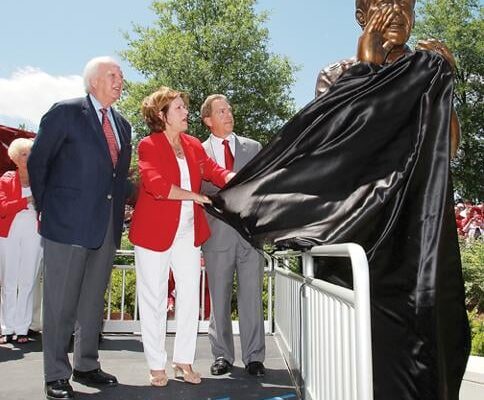“The Alabama Crimson Tide has unveiled a life-size bronze statue celebrating the legendary legacy of Head Coach Nick Saban.”
The Alabama Crimson Tide has unveiled a life-size bronze statue celebrating the legendary legacy of Head Coach Nick Saban, immortalizing one of the most influential figures in the history of college football. The statue, standing prominently outside Bryant-Denny Stadium in Tuscaloosa, serves not only as a tribute to his unparalleled achievements on the field but also as a symbol of the cultural and athletic renaissance he brought to the University of Alabama.
Nick Saban arrived in Tuscaloosa in 2007, taking over a program steeped in tradition but yearning for a return to dominance. At the time, Alabama football was caught in a cycle of coaching instability, inconsistent performances, and unmet expectations that had plagued the Crimson Tide since the end of the Bear Bryant era. In less than two decades, Saban not only revived the program but elevated it to unprecedented heights, crafting a dynasty that defined a generation of college football and left an enduring legacy that transcends wins and championships.
The statue’s unveiling drew a large crowd of alumni, fans, players, and university officials. Emotions ran high as the bronze figure, clad in Saban’s trademark coaching attire—visor, polo shirt, and khakis—was revealed. Sculpted with meticulous attention to detail, the statue captures Saban’s intense sideline demeanor, his signature stance with crossed arms and a focused gaze that became synonymous with Alabama’s relentless pursuit of perfection. The figure exudes authority and vision, attributes that Saban exemplified throughout his tenure.
University President Dr. Stuart Bell spoke at the ceremony, describing Saban as “a transformative leader who not only shaped a football program but elevated an entire university community.” He praised Saban for instilling values of discipline, commitment, and excellence both on and off the field. Athletic Director Greg Byrne echoed those sentiments, noting that Saban’s impact reached far beyond the gridiron, influencing university admissions, alumni engagement, and national visibility. Under Saban, Alabama became a destination school, with applications soaring and academic standards rising in tandem with football success.
Saban’s record is as decorated as it is historic. During his time at Alabama, he led the Crimson Tide to six national championships (2009, 2011, 2012, 2015, 2017, and 2020) and secured nine SEC titles. His teams were known for their dominance, discipline, and adaptability, often redefining themselves each season to remain ahead of evolving college football trends. From the hard-nosed, defensive-led squads of the early 2010s to the high-powered, explosive offenses of the later years, Saban demonstrated an unmatched ability to innovate and evolve.
Yet what set Saban apart was not merely his strategic acumen but his approach to leadership and development. He implemented “The Process,” a philosophy emphasizing preparation, mental toughness, and incremental progress. This method became the foundation of Alabama’s success and a model emulated by programs across the country. Saban’s practices were famously grueling and precise, designed to forge resilience and discipline. He demanded excellence and accountability, fostering an environment where players thrived under pressure and learned life lessons that extended beyond football.
His coaching tree, too, is a testament to his influence. Numerous former assistants under Saban have gone on to become head coaches at major programs, including Kirby Smart (Georgia), Lane Kiffin (Ole Miss), Steve Sarkisian (Texas), and Jimbo Fisher (Texas A&M), among others. While each has carved their own path, many credit their success to the foundation laid under Saban’s tutelage. His legacy is thus not only measured in titles and trophies but in the ripple effect of leadership and mentorship that continues to shape college football.
Beyond the Xs and Os, Saban was a figure of consistency and discipline in a sport increasingly defined by rapid change. He navigated the evolving landscape of college football—from the implementation of the College Football Playoff and the spread of high-tempo offenses to the era of NIL deals and the transfer portal—with remarkable poise and foresight. In many ways, he was a stabilizing force, anchoring Alabama amid the sport’s shifting tides and ensuring the Crimson Tide remained at the forefront of national conversation.
Off the field, Saban and his wife Terry made profound contributions to the community through their Nick’s Kids Foundation, which supported educational and philanthropic initiatives across Alabama. The Sabans prioritized giving back, frequently engaging in local events and donating millions to causes ranging from disaster relief to children’s healthcare. Their commitment to service was a cornerstone of their tenure in Tuscaloosa, reinforcing the idea that success is best measured by the positive impact one has on others.
The decision to honor Saban with a statue places him among the pantheon of Alabama legends. His figure joins those of past greats like Paul “Bear” Bryant, Wallace Wade, and Gene Stallings, whose own statues stand nearby. It is a reminder that while football is played in seasons, legacies endure for generations. For many fans, especially those who grew up during the Saban era, the statue serves as a time capsule of memories—of thrilling wins, unforgettable players, and championship parades through downtown Tuscaloosa.
Current and former players were in attendance, many visibly moved by the ceremony. Quarterback Bryce Young, who led the Tide during their 2021 campaign and won the Heisman Trophy under Saban’s guidance, spoke of the coach’s influence on his development as both an athlete and a person. “Coach Saban always challenged us to be the best versions of ourselves,” Young said. “He believed in the little things—the habits, the discipline, the details. That mindset changed my life.”
Indeed, Saban’s emphasis on character and preparation became a hallmark of the Alabama program. He often said that success was a byproduct of doing the right things consistently, a belief that resonated throughout the university and inspired a culture of excellence that extended into classrooms, offices, and beyond. His methods, though intense, were deeply rooted in the idea of maximizing potential and creating opportunities.
While statues are static, legacies are dynamic. As Alabama moves forward into a new era, the presence of Saban’s likeness outside the stadium serves as a guiding light, a standard to uphold. The university has already begun transitioning into life after Saban following his retirement, a monumental shift that brings both challenge and opportunity. The next head coach inherits not just a team, but a tradition shaped by one of the greatest to ever lead on the sidelines.
For Saban himself, the statue is not merely a monument to victories but a symbol of the journey—one marked by dedication, transformation, and a relentless commitment to doing things the right way. In typical fashion, he downplayed the honor during his brief remarks at the unveiling. “This isn’t about me,” he said. “It’s about the players, the coaches, the fans, and everyone who’s been a part of this incredible ride. I’ve been blessed to be a part of the Alabama family.”
The Alabama faithful would beg to differ. To them, Nick Saban was not just a part of the family—he was the patriarch of a golden era, the architect of modern Alabama football, and the person most responsible for restoring pride, prestige, and power to the Crimson Tide. His statue, cast in bronze, now stands watch over a stadium that roared with triumphs under his command. It will remain there for generations to come, telling the story of a man who dared to dream bigger, demand more, and deliver excellence time and again.
As the sun set over Tuscaloosa on the day of the unveiling, the statue shimmered with a golden hue, almost as if reflecting the glow of a thousand memories. Fans lingered long after the ceremony, snapping photos and reminiscing about their favorite Saban moments. Some spoke of title-clinching wins, others of unforgettable comebacks or legendary players. But all agreed on one thing: Nick Saban changed Alabama football forever. The statue is a testament to that change—etched not just in metal, but in the hearts and history of the Crimson Tide.



